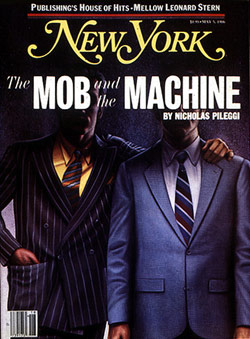 |
From the May 5, 1986 issue of New York Magazine.
FBI agents who have spent their careers memorizing the nicknames and roles of New York's organized-crime hoods have suddenly found themselves thumbing through copies of The Green Book, the city's official directory. It turns out that many mob middlemen, and even a few top hoods, have begun showing up in the current political scandals.
So many connections have been made that some agents have had to draw up color-coded charts (Gambino, blue; Lucchese, yellow; Colombo, pink; Genovese, red; Bonanno, green) to help them keep track of the complicated web linking the hoods and the city's political machine.
"The mob has always had some influence in politics, and in the past, they even had their own candidates in one or two key spots," said Ron Goldstock, head of the state's Organized Crime Task Force. "But now we are beginning to see evidence of a pervasive presence. It's practically open. We've even begun to see partnerships in which mobsters and city officials were in business together."
Rudolph Giuliani, the U.S. Attorney in Manhattan, said the organized-crime groups have grown so emboldened that mob-linked companies have begun making campaign contributions on the books. "There was a day when hoods might have slipped money to people under the table," Giuliani said, "but we're beginning to find that many of the companies linked to organized crime have openly contributed to political campaigns"—the subject of yet another investigation.
The renewed concern about the influence of organized crime in city politics comes at a time when the mob itself is under pressure. In the last year, federal and state prosecutors have brought several big cases against major mob figures. And, perhaps because of the federal and state crackdown, a power battle has apparently erupted within the mob. The latest piece of evidence is the April 13 car bombing that killed Gambino crime-family under-boss Frank DeCicco.
Of the almost two dozen separate federal and local investigations that have been kicked off by allegations of bribery in the city's Parking Violations Bureau, at least a half-dozen now involve links to the mob. These include:
• The secret real-estate partnership between former Department of Transportation commissioner Anthony Ameruso and Angelo Ponte, an alleged mobster.
• The curious comings and goings of reputed mob money-launderer Michael W. Callahan, who was one of the few non-family members to visit former Queens borough president Donald Manes in the days just before Manes killed himself.
• The relationship between indicted Bronx County Democratic leader Stanley Friedman and a top aide, Paul Victor, the son of an organized-crime member. Victor was a secret partner in a printing firm that had no plant facilities yet received a total of $250,000 from Friedman's campaign committees.
• The relationship between City Planning commissioner Theodore Teah and Robert Hopkins, a six-foot-five-inch, 250-pound organized-crime policy operator who has been charged with ordering the murder of a mob rival.
• The connections between former Taxi and Limousine commissioner Jay Turoff and a casino employee with reputed links to the mob.
Other investigations sparked by the political scandals are trying to learn why $22 million in city contracts was awarded to a plumbing company that employed Gambino crime boss John Gotti and whose owners were indicted last June for obstructing justice in a heroin case involving Gotti associates; why a towing company linked to a Lucchese consigliere has kept its exclusive Department of Transportation contract with the city for five years; and whether mob influence was involved in a controversial landfill and marina project in Queens. One of the project's partners, a man who is under indictment for tax fraud, ran a catering operation and restaurant that's known as a Gotti hangout.
What's more, several politically linked mob cases that were under way before the municipal scandals broke are now being seen as part of a larger pattern. In Queens, former State Supreme Court judge William Brennan was convicted in December of taking a bribe from an organized-crime hood to fix a mob case. Brennan also showed up as a partner in the real-estate deal involving Ameruso.
And in the Bronx, Democratic state senator Joseph Galiber is awaiting trial with reputed mob soldier William "Billy the Butcher" Masselli. The two are charged with running a phony minority trucking firm that allowed a company run by former secretary of labor Raymond Donovan to qualify for the $186 million 63rd Street tunnel contract.
More investigations of the links between the mob and the machine are being opened almost weekly, and—in light of what's come out recently—the Feds are reopening cases put aside several years ago. For example, they'd like to know more about the 1983 mob-style death of Rick Mazzeo, a real-estate director for the Department of Marine & Aviation. Mazzeo's body was found in the trunk of a car in Greenpoint just before he was supposed to testify about ripoffs of city leases.